Growing Vanilla beans in your garden can be a rewarding and fascinating experience. You can cultivate these prized beans right at home with the proper knowledge and care. Each step is crucial in ensuring their successful growth, from choosing the right location to harvesting and curing the beans.
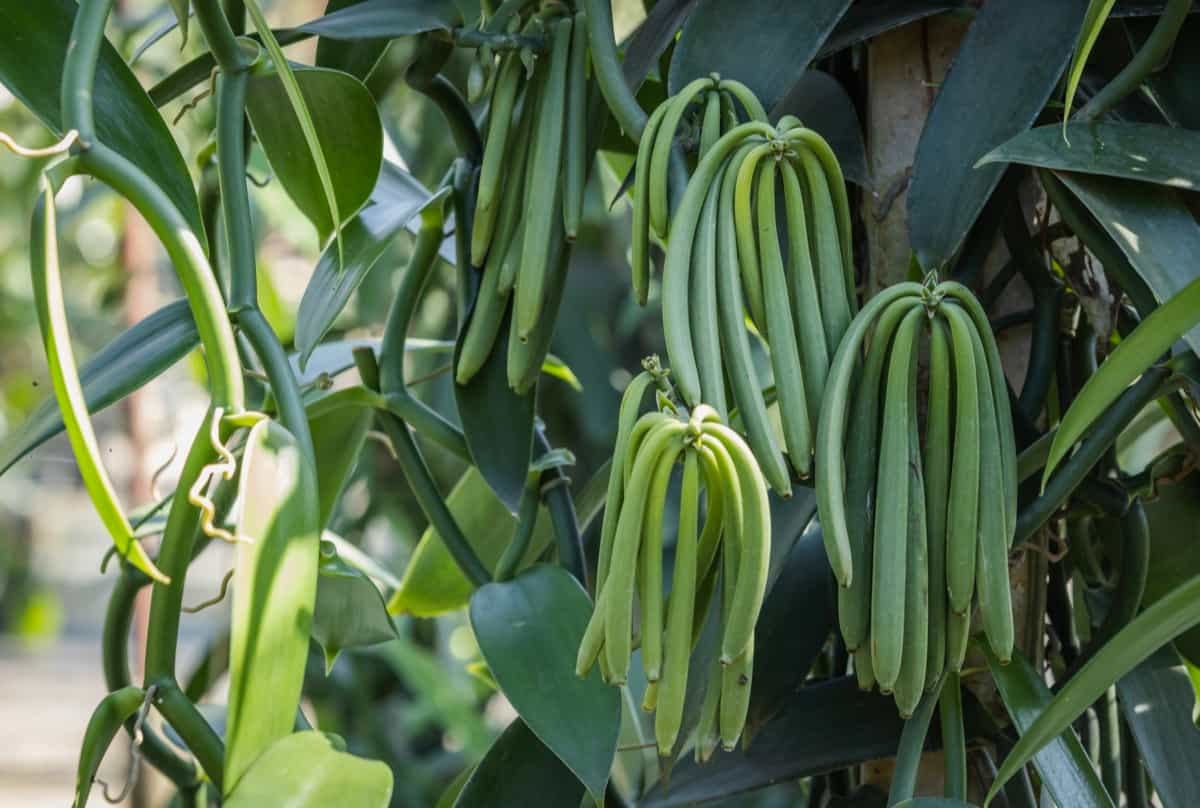
Remember that Vanilla plants require specific conditions to thrive, such as warm temperatures, filtered sunlight, and well-draining soil. By providing them with these essentials and giving them proper attention throughout their growth cycle, you’ll have the opportunity to harvest your Vanilla beans.
Growing Vanilla Beans in Your Garden
Selecting the Right Vanilla Bean Variety
| Variety | Flavor Profile | Growth Requirements |
| Tahitian | Floral, fruity | Warm temperatures |
| Bourbon | Sweet, creamy | Tropical climate |
| Mexican | Spicy, woody | Hot and humid |
| Ugandan | Earthy, smoky | Moderate temperature |
Preparing the Soil for Vanilla bean Planting
Preparing the soil for planting Vanilla beans ensures their successful growth and development. The first thing you need to consider is the texture of the soil. Vanilla beans thrive best in well-draining, loamy soil that retains some moisture but doesn’t become waterlogged. Mix organic matter into your garden bed to achieve this ideal soil texture.
In case you missed it: How to Grow and Care for Yardlong Beans/Asparagus Beans From Seed
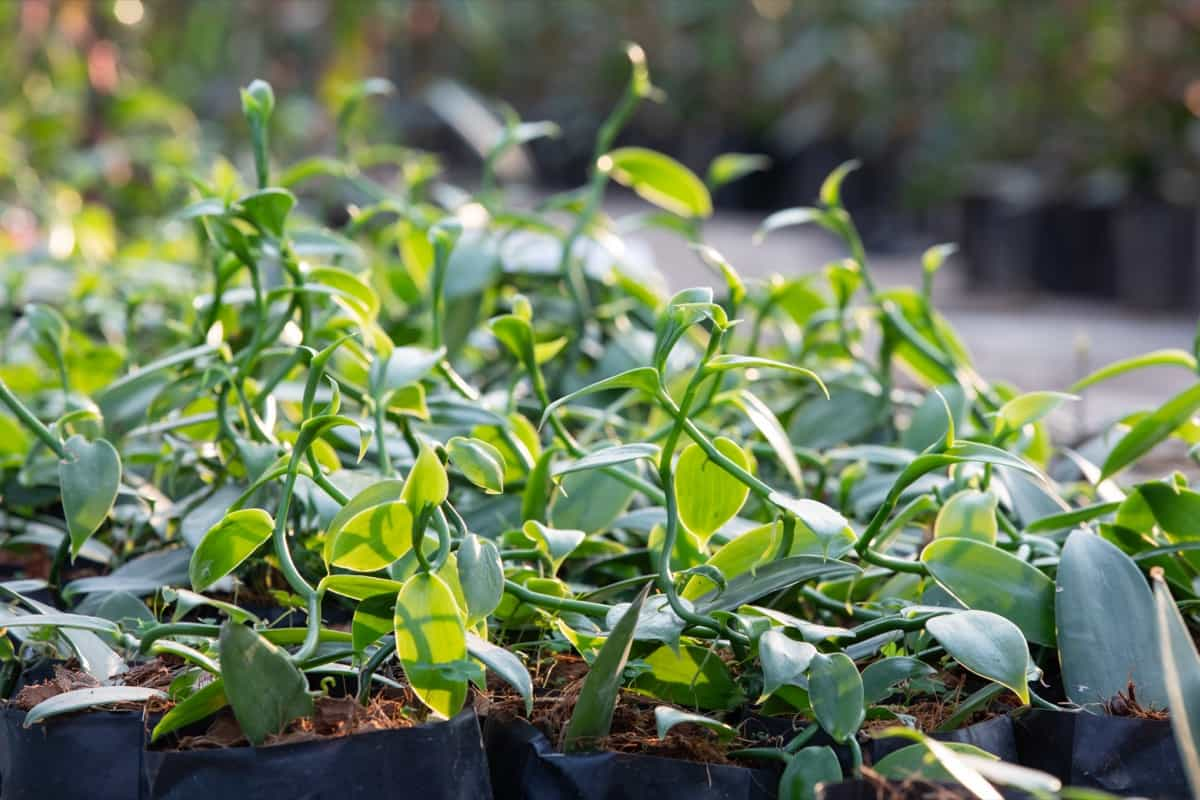
This will improve drainage and nutrient content, creating a fertile environment for your Vanilla plants to flourish. Next, it’s essential to check the pH level of your soil. Vanilla beans prefer slightly acidic conditions with a pH range of 5.5 to 7. If your garden soil is acidic or alkaline, you can adjust by adding lime (to lower acidity) or sulfur (to raise acidity). Furthermore, ensure that the area where you plan to plant Vanilla beans receives ample sunlight throughout the day.
Getting High-Quality Vanilla bean Seeds or Cuttings
One of the most critical steps in growing Vanilla beans is obtaining high-quality seeds or cuttings. These will serve as the foundation for your plants and ultimately determine their success. When selecting Vanilla bean seeds, sourcing them from a reputable supplier is crucial. Select healthy stems from mature Vanilla plants if you prefer starting with cuttings instead of seeds.
Look for green, plump stems that show no signs of disease or damage. It’s best to take cuttings during the warmer months when the plant is actively growing. Handling your seeds or cuttings with care is essential once you have obtained your seeds or cuttings. Store them in a cool and dry place until you’re ready to plant them in well-draining soil.
Sunlight and Water Requirements for Vanilla beans
Sunlight and water are essential for successfully growing your garden’s Vanilla beans. These tropical plants thrive in warm climates with plenty of sun, so providing them with the right light is necessary. Vanilla beans require at least six hours of direct sunlight each day. Find a spot in your garden that receives ample sunlight, preferably in a south or west-facing direction.
Regarding watering, Vanilla bean plants prefer consistently moist soil but not overly saturated conditions. Be mindful not to overwater, leading to root rot and other fungal diseases. To maintain proper moisture levels, mulching around the base of the plant can be beneficial. Organic mulch like wood chips or straw works well for this purpose.
Temperature and Humidity Requirements for Vanilla beans
These tropical plants thrive in warm climates with temperatures ranging between 21 to 35°C. Ideally, Vanilla beans require a consistent temperature throughout the year, avoiding extreme fluctuations. They are sensitive to cold weather and frost, so protecting during colder months is essential. Regarding humidity, Vanilla beans prefer high levels ranging from 80% to 90%.
This means they need a humid environment like their natural habitat. You can achieve this by misting the plants regularly or using a humidifier if necessary. To maintain optimal conditions for your Vanilla bean plants, consider creating microclimates within your garden or greenhouse. You can control temperature and humidity levels more effectively by implementing shade cloth or providing adequate ventilation.
In case you missed it: Growing Green Beans from Seed to Harvest: How to Start from Scratch, A Detailed Guide for Beginners
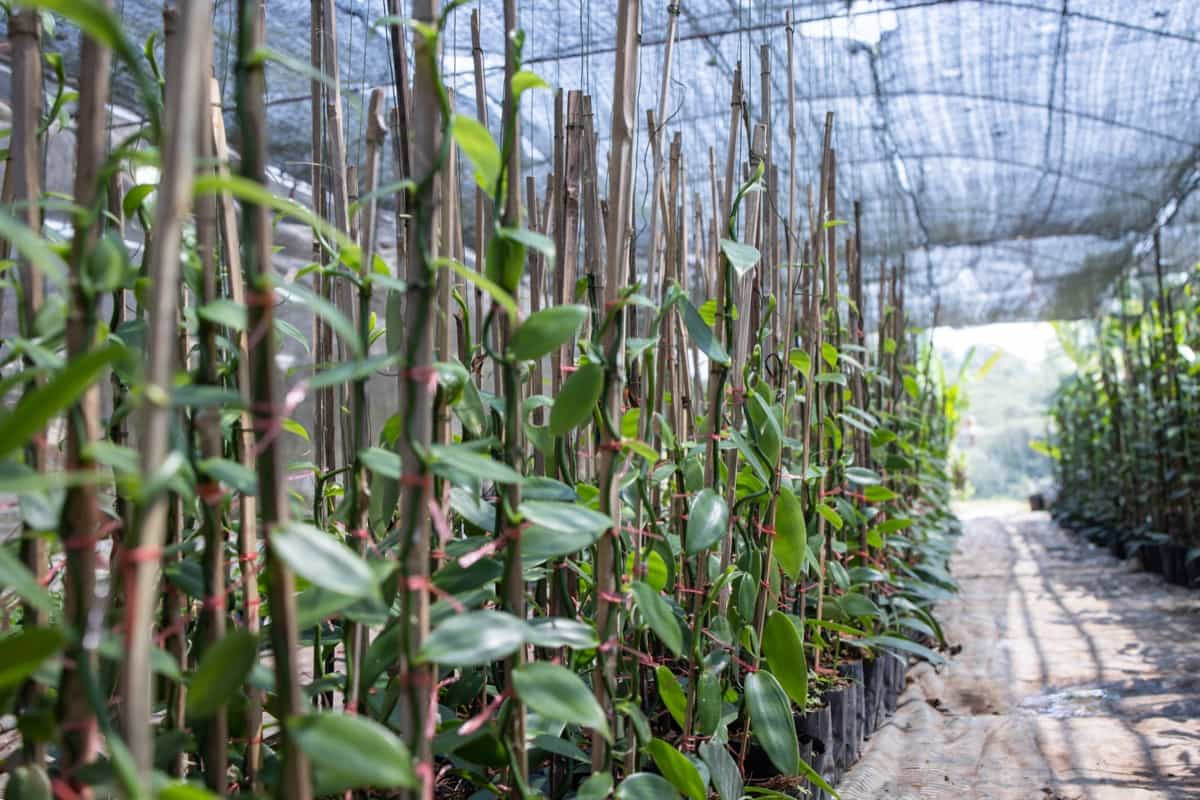
Propagation of Vanilla Beans through Cuttings or Seeds
If you’re interested in growing Vanilla beans in your garden, you have a couple of options when it comes to propagation: cuttings or seeds. Experienced gardeners often prefer cuttings because they offer a quicker and more reliable way to propagate Vanilla beans. Select a healthy Vanilla bean plant and carefully remove a piece of stem with several nodes to propagate through cuttings.
Plant the cutting in well-draining soil and provide it with the right conditions for growth. On the other hand, propagating Vanilla beans from seeds can be a bit trickier but rewarding, nonetheless. Soak the vanilla bean seeds in warm water for 24 hours to soften their hard outer coating. Then, plant the seeds in a moist potting mix and keep them warm until germination occurs.
While both methods can be successful, keep in mind that propagation from cuttings is generally recommended for beginners due to its higher success rate. However, if you’re up for a challenge, trying your hand at growing Vanilla beans from seeds can be an exciting endeavor. Remember that patience is key when propagating Vanilla beans, as they are known for their slow growth rate. So, whether you choose cuttings or seeds, provide consistent care and watch as your plants slowly thrive.
Controlling Pests and Diseases in Vanilla bean Plants
| Pest/Disease | Symptoms | Control Methods |
| Aphids | Sticky residue on leaves | Spray plants with insecticidal soap. |
| Spider Mites | Webbing on leaves | Wash leaves with a strong stream of water or use predatory mites. |
| Scale Insects | Small, oval-shaped insects | Remove scales manually or apply horticultural oil. |
| Fusarium Wilt | Wilting of leaves | Improve soil drainage and avoid overwatering. |
| Anthracnose | Dark spots on leaves | Prune affected parts and apply copper-based fungicide. |
When to Harvest Vanilla Beans: Is This Right Time?
Knowing when to harvest Vanilla beans is crucial to achieving the best flavor and quality. Generally, Vanilla beans are ready for harvesting when they have reached their full size and turned yellow or brown. However, this can change depending on the variety of Vanilla beans you are growing and the climate in which you are growing them.
In case you missed it: Soil Preparation for Green Bean Plants: Best Soil Mix, pH, Compost, and Recipe
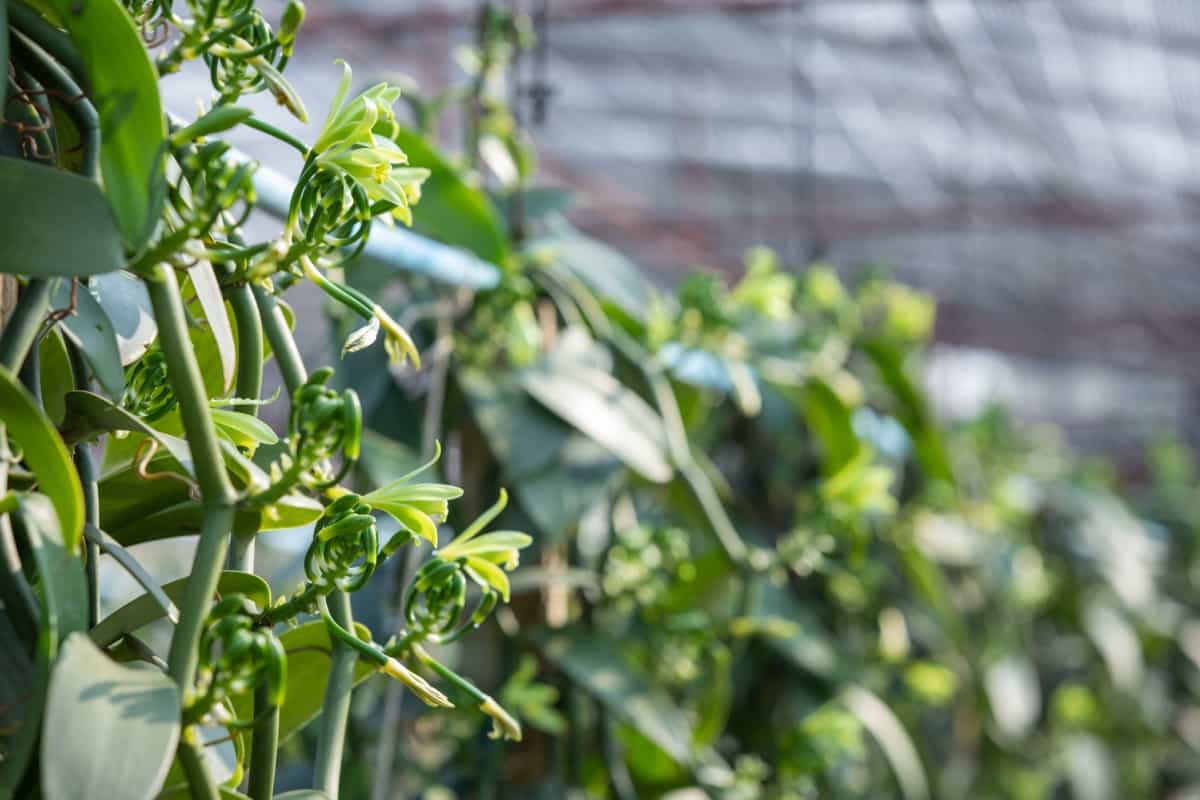
To determine if your Vanilla beans are ready for harvest, gently squeeze one between your fingers. It is likely prepared to be harvested if it feels plump and moist without any hardness or sponginess. Another indicator is a sweet fragrance emanating from the pods. It’s also important to consider the time of year when deciding when to harvest your Vanilla beans. In most regions, Vanilla plants will flower once a year during certain months. After flowering, it takes several months for the pods to mature and ripen before they can be harvested.
Drying and Storing Vanilla Beans
| Cleaning | Start by gently wiping off any dirt from the surface of the beans using a clean, damp cloth. |
| Drying | Lay the Vanilla beans in a single layer on a clean, dry surface, such as a wire rack or parchment paper-lined tray. |
| Air drying | Allow the beans to air dry for about 2-4 weeks until they become dark brown and leathery to the touch. Turn them occasionally during this period for even drying. |
| Conditioning | Once dried, it’s time to condition your Vanilla beans for optimal flavor development. Place them in an airtight container like a glass jar or vacuum-sealed bag. |
| Storing | Store your conditioned Vanilla beans in a cool, dark place like your pantry or cupboard, away from any strong odors that could impact their taste. |
Growing Vanilla Beans in a Greenhouse or Indoor Container
Growing Vanilla beans in a greenhouse or indoor container can be a great option if you don’t have access to a suitable outdoor space. Not only does it allow you to control the growing conditions more effectively, but it also extends the growing season for these tropical plants. When choosing a greenhouse or container, ensure ample space for the vine to climb and grow. A trellis or support system is essential for Vanilla beans as they are natural climbers. You can use bamboo poles or wireframes to create this structure.
In case you missed it: How to Grow Serviceberries in a Home Garden: A Step-by-Step Guide

For soil, opt for a well-draining potting mix rich in organic matter. Vanilla beans prefer slightly acidic soil with pH levels ranging from 5.5 to 7. Regularly check moisture levels and water, ensuring the soil remains moist but not waterlogged. Sunlight is crucial for the healthy growth and flower production of Vanilla beans. Place your greenhouse or container in a location where it receives bright, indirect sunlight for at least 6-8 hours per day. Supplemental lighting may be necessary during darker months or if natural light is limited.
Maintaining proper temperature and humidity levels within your enclosed environment is vital. Vanilla beans thrive between 21-35°C during the day and slightly cooler temperatures at night. Aim for humidity levels around 80% to mimic their native rainforest habitat. Regularly check your plants for any symptoms of pests such as aphids, spider mites, or mealybugs, which can infest indoor environments easily due to a lack of natural predators. Use organic pest control methods.
Frequently Asked Questions (FAQ) about Growing Vanilla Beans in Your Garden
What Are the Best Varieties of Vanilla Beans to Grow in My Garden?
Selecting a suitable variety is crucial when growing Vanilla beans in your garden. Different varieties of Vanilla beans have distinct flavors and aromas, so choosing the best one for your taste preferences is essential. One popular variety is Bourbon Vanilla. Another excellent choice is Tahitian Vanilla. If you prefer a more exotic flavor, consider growing Mexican Vanilla. There are rare varieties like Ugandan Vanilla for those who want something unique. These varieties offer distinct regional flavors that can elevate your culinary creations.
When Is the Best Time to Plant Vanilla Beans in My Garden?
When planting Vanilla beans in your garden, timing is everything. The best time to plant Vanilla beans largely depends on your area’s climate and growing conditions. Generally, it is recommended to plant Vanilla beans during the warmer months when temperatures are consistently above 21°C.
This ensures that the plants have enough warmth and sunlight to thrive. For those living in tropical regions where temperatures remain relatively warm throughout the year, any time can be suitable for planting Vanilla beans. However, it is still essential to consider factors such as rainfall patterns and humidity levels.
Can I Grow Vanilla Beans in a Container or Indoor Pot?
Growing Vanilla beans in a container or indoor pot is possible and can be an excellent option for those with limited outdoor space. With the right conditions and care, you can successfully cultivate these aromatic beans right in the comfort of your own home. When choosing a container for your Vanilla bean plant, opt for one with good drainage to prevent waterlogged roots.
A container with at least 12 inches in depth is recommended to accommodate the long root system of Vanilla plants. To provide optimal growing conditions, place your potted Vanilla bean plant near a sunny window that can receive bright but indirect sunlight. If natural light is insufficient, you may consider using artificial grow lights to supplement the lighting needs of your plant.
How Long Does It Take for Vanilla Beans to Mature and Produce Flowers?
Vanilla beans are not the quickest crop to mature and produce flowers, but with patience, you can enjoy the rewards of your efforts. It takes three to five years for Vanilla beans to mature and flower. During the first year of growth, your Vanilla bean plant will focus on establishing its root system and developing strong vines.
In case you missed it: 14 Creative Ideas for Small Balcony Vegetable Gardens
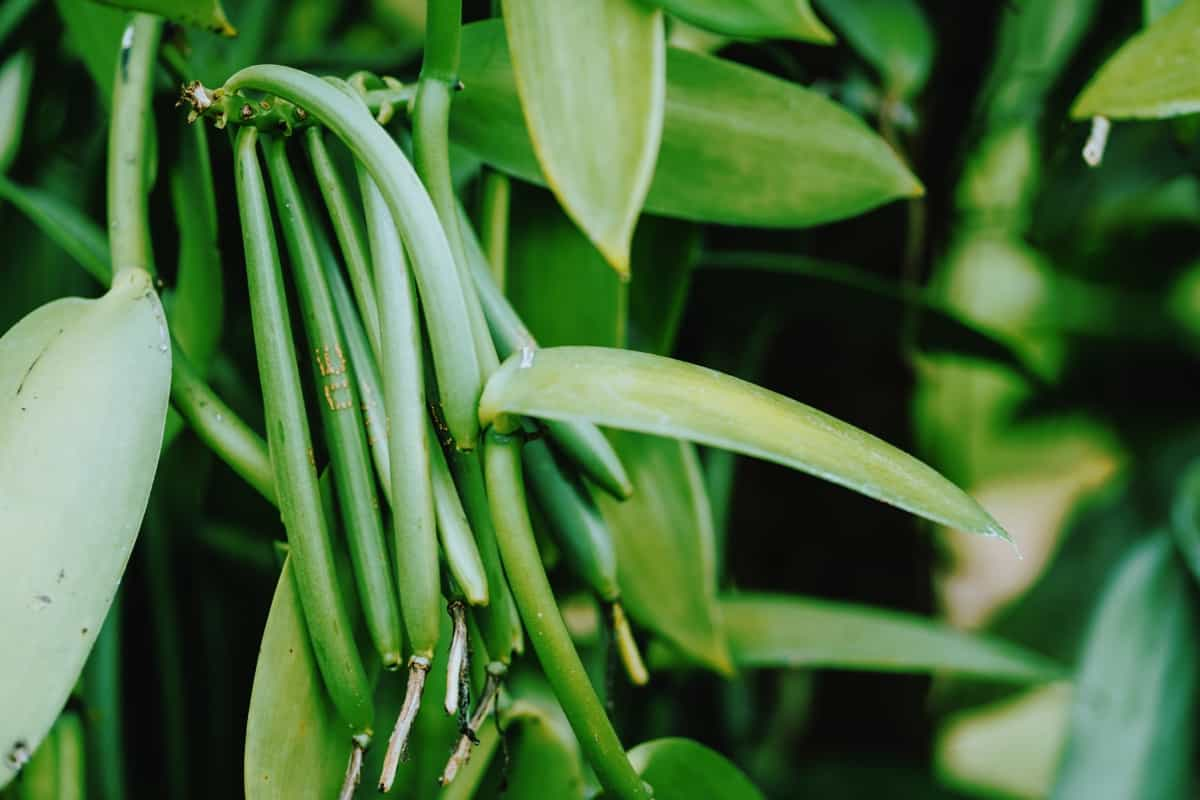
This stage is crucial for setting a solid foundation for future growth. As the plant strengthens, you may see limited vegetative growth in the second and third years. Vanilla plants often begin producing their delicate white flowers in the fourth or fifth year. These blossoms only last for one day before they need to be manually pollinated by hand or through natural methods such as bees or hummingbirds.
How Do I Store Vanilla Beans Once They Are Harvested?
After patiently waiting for your Vanilla beans to mature and harvesting them at the perfect time, you’ll want to store them properly to maintain their flavor and quality. Keeping Vanilla beans may seem simple, but a few key factors must be considered. It’s important to note that fresh Vanilla beans have a high moisture content and need proper drying before storage. Start by rinsing the harvested beans with cold water and patting them dry with a clean towel.
Then, lay them out in a single layer on a clean surface in a well-ventilated area. Placing the beans on wire racks or mesh screens instead of directly on solid surfaces is best to ensure proper airflow during drying. This helps prevent mold or rot from developing. Allow the beans to air dry for about 2-3 weeks until they become leathery and pliable. Once dried, you can store your Vanilla beans in an airtight container. Ensure the container is completely sealed to prevent any moisture from entering, which could cause spoilage.
Conclusion
Growing Vanilla beans in your garden can be a rewarding and fulfilling experience. Not only will you have the satisfaction of cultivating a rare and valuable spice, but you’ll also enjoy the beautiful sight of lush green vines winding their way up trellises or trees. Remember to choose the suitable variety that suits your climate and ensure that you provide them with proper care throughout their growth cycle.
Once it’s time for harvest, don’t forget to properly process your Vanilla beans to extract their rich flavors fully. Patience and dedication will reward you with homemade Vanilla pods that can elevate any recipe.
- Broccoli Seed Germination and Selection
- Asparagus Seed Germination and Variety Selection
- Seasonal Flower Gardening: Best Practices for Spring, Summer, Fall, and Winter
- How to Grow Hibiscus from Flower
- Plantation Ideas for Home Decoration: A Beginners Guide
- Flower Garden Designs and Layouts for Beginners
- Planting and Spacing Techniques in Papaya: A Beginner’s Guide
- Growing Gold: Essential Techniques for Planting Pineapples
- How to Make Kalanchoe Plant Bushy: Home Remedies and Solutions
- 11 Reasons Why Your Gardenia is Not Blooming: Home Remedies and Solutions
- Eco Elegance: The Guide to Designing a Drought-Tolerant Landscape
- Gardening on a Slope: Strategies for Hillside Landscaping
- Nourish and Flourish: Top Organic Mulches for Thriving House Plants
- Everything You Want to Know about Indian Mogra Flower: Discover Uses and Growing
- Green Thumb Success: Expert Tips for Cultivating Greenhouse Pumpkins All Year Round
- Maximize Growth & Flavor: The Ultimate Guide to Companion Planting in Herb Gardens
- How to Control Rhododendron Problems Naturally: Home Remedies and Organic Ways to Fix Them
- Natural Magic: The Remarkable Benefits of Cinnamon for Plants
- Best Steps to Revive Dying Tulip with Natural and Organic Treatment
- 10 Reasons Why Your Angel Trumpet is Not Blooming: Remedies and Treatment
- How to Fix Periwinkle Leaf and Flower-Related Problems: Natural Remedies and Solutions
- How to Fix Zinnias Leaf and Flower Problems: Discover Natural and Home Remedies
- Organic Steps to Induce Lemon Tree Flowers: A Comprehensive Guide
- Bloom Booster: Crafting the Perfect Homemade Bougainvillea Fertilizer
- Optimizing Growth: A Guide to Applying NPK Fertilizer for Potted Plants
- 10 Best Homemade Fertilizers for Rubber Plant: DIY Recipes and Application Method
- How to Boost Female Pumpkin Flowers: Effective Steps for More Flowers and High Yields
- Transform Your Indoor Garden: Top Benefits of Pink Salt for Houseplants
- 10 Best Homemade Fertilizers for Peacock Plants (Calathea): Easy DIY Guide
- Unlock Blooms: 9 Reasons Why Your Potted Chrysanthemum is Not Blooming
- 8 Reasons Why Your Potted Hibiscus is Not Blooming: Fix it with Simple Solutions
- Unlock Blooms: 9 Key Reasons Your Potted Frangipani Won’t Flower
- 10 Reasons Why Is My Ice Plant Not Blooming: Remedies and Treatment
- 10 Reasons Why My Potted Hydrangea Not Blooming: Treatment and Remedies
- 10 Reasons Why is My Wisteria Not Blooming: Remedies and Treatment
- 10 Reasons Why is My Goldfish Plant Not Blooming: Remedies and Treatment